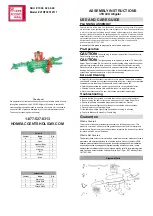
PROFIBUS / RS 485
24
DDLS 200
Leuze electronic
Changeover PROFIBUS / RS 485 (default: ’Off’ = PROFIBUS)
The DDLS 200 has, as a standard function, a repeater function (signal processing) and is, with regard
to the PROFIBUS, to be viewed as a repeater.
5.4
LED indicators PROFIBUS
In addition to the indicators and operational controls present in all device models (bar graph, buttons,
LEDs AUT, MAN, ADJ; see chapter 11.1 "Indicators and operational controls"), the PROFIBUS model
also has the following indicators:
Figure 5.5: Indicators and operational controls of the PROFIBUS model
NOTE
Please observe the guidelines specified in EN 50170 (Vol. 2) regarding the use of
repeaters. The delay time of a data transmission path is maximum 1.5 µs + 1 TBit.
It is also possible to transmit other RS 485 protocols. For PROFIBUS applications, S3-4
should be set to 'Off' ('0'). DIP-switch S3-4 can be used to switch off the repeater function
for non-PROFIBUS applications (S3-4 = 'On'). In this case, no signal regeneration takes
place; the RS 485 protocol must, however, still provide certain features
Please contact the manufacturer if you would like to use the DDLS 200 for general RS 485
protocols.
PWR Tx
Rx
AUT
MAN
ADJ
LED PWR: green
= operation indicator
green flashing= transmitter / receiver unit switched off
via switching input IN or hardware error
off
= no operating voltage
LED Tx:
green
= data is being transmitted to the bus
green flashing= with baud rates set to very low values,
the LEDs Tx and Rx flicker. At very
high baud rates (> 50kBit/s), flashing
LEDs Tx and Rx indicate faulty bus
communication.
off
= no data on the transmission line
LED Rx:
green
= data is being received by the bus
green flashing= with baud rates set to very low values,
the LEDs Tx and Rx flicker. At very
high baud rates (> 50kBit/s), flashing
LEDs Tx and Rx indicate faulty bus
communication.
off
= no data on the receiving line
DDLS200_E.book Seite 24 Mittwoch, 19. Februar 2020 12:22 12
















































